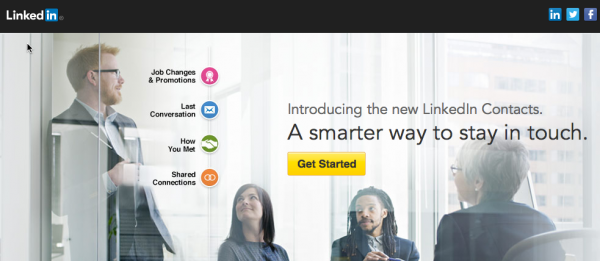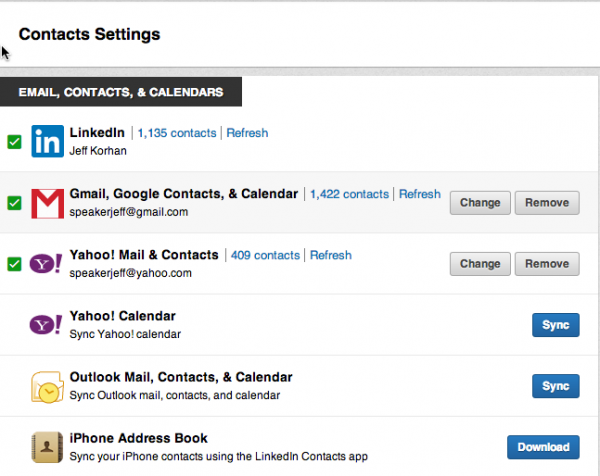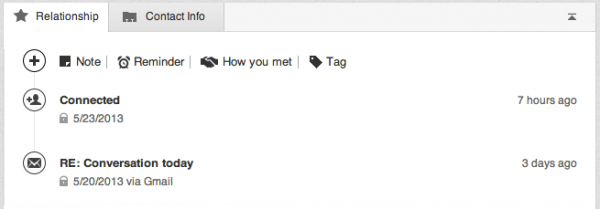
LinkedIn is in the process of rolling out LinkedIn Contacts. In addition to several new features that are giving it a new look and feel – if offers enhanced functionality for better managing your relationships and social engagement.
There is no question that all of the major social networks want you to use their service as your social dashboard. However, many social networkers prefer to use an independent tool such as Hootsuite to effectively manage their social networks and build relationships.
One of the challenges is there is a disconnect between public social networking and private means of communication that often lead to sales conversion – namely email. This is where services such as Nimble are leading the way, by bringing social and email into one dashboard, and one reason why I especially like LinkedIn Contacts.
What gets even more interesting is that concurrent with LinkedIn’s rollout of LinkedIn Contacts, Nimble has launched Nimble 3.0, and there are some interesting contrasts and similarities. More on how Nimble brings big data to small business.
For now, here’s how to get the most out of LinkedIn Contacts.
#1 – Import Your Contacts
You have always been able to import your contacts from other sources into LinkedIn. However, now with LinkedIn Contacts there are multiple options for doing this – while also tracking where the source of those contacts. To get started, just go to contacts in your LinkedIn profile, and then settings.

Some of the possible sources for importing contacts into LinkedIn
What is especially useful is the refresh button. So, let’s say you imported your friends from Facebook a month ago, just hit the refresh button to bring in the new ones.
Incidentally, while Facebook does not let you export the email addresses of your friends, there is a workaround using Yahoo Contacts to import your Facebook contacts into LinkedIn. Since Facebook is not prone to sharing, I suggest doing this now to avoid the risk that this capability will be blocked in the future.
Know that you won’t get all of them, because not everyone has an email address publicly linked to their Facebook profile.
#2 – Set Reminders to Connect
It’s easy to make that first connection, but anybody that has ever attended a live networking event knows that often nothing happens after that. In the old days, business cards got pushed into a drawer. Today, connections are made and forgotten days later.
The technology expertise and implementation experience to help you get the most out of your Microsoft investment. For over 20 years, database services and Remote DBA.com have been helping businesses become more agile, lower costs, prepare for mobile and IoT, and ensure their applications meet the needs of your customers and employees.
So, a great solution is to use LinkedIn Contacts to set a reminder to follow-up with your connections a few weeks or so later. At the very least, your new connection will be impressed with your organization, and if you can also share some useful information, better yet.

LinkedIn reminders, tags, notes, and conversation history
#3 – Merge Duplicate Contacts
Many people unknowingly or not set up multiple profiles on LinkedIn. As a result, you may find yourself connecting with their abandoned profile because they did not delete it.
Now LinkedIn pulls up what they believe to be all duplicate profiles so that you can merge them. You simply unclick those on the list where the same name is actually two different people. Then just click merge and just like that – you have cleaned up your database
#4 – Tag Your Connections
It appears that LinkedIn automatically assigns a tag such as colleague or friend based upon the respective social graphs or source of the contacts. Regardless, you should be making the effort to accurately tag your connections
This is the true power of a CRM – using tags to create micro-communities. If you do not have a means for targeting your message for a specific community, then you run the risk of having it reduced to spam.
When that happens, your ability to connect with future opportunties is compromised, because you have lost the trust that you may have otherwise earned.
#5 – Note Relevant Information
I have always wondered about the privacy of the notes feature in LinkedIn, and have now confirmed that profile notes are private to you.
So, when you make a connection, jot down important notes for later use – including how your met and any opportunities that may have been discussed. It’s easy to forget, so take the time now, so that when that follow-up reminder pings you later you’ll recall important information.
LinkedIn co-founder Reid Hoffman likes to say, “It’s better to be the best connected than the most connected.”
Now LinkedIn is not only giving you the tools to do so, but making them seamless and easy to use for getting more from this platform.
In addition to that, LinkedIn plays well with others. So, while Google and Facebook continue to slug it out on their respective properties, it’s nice to know you can count on LinkedIn as a friendly and neutral partner.
If you are still looking for more from LinkedIn, consider setting up your LinkedIn Business Page.
How about you? How are you using LinkedIn to grow your business?
About the Author: Jeff Korhan, MBA, helps mainstream small businesses create exceptional customer experiences that accelerate business growth. Get more from Jeff on LinkedIn, Twitter and Google+.
Jeff is also the author of Built-In Social: Essential Social Marketing Practices for Every Small Business – Just Released April 2013 (Wiley)


